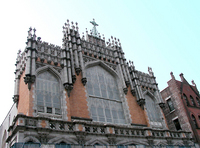Preservation very different up the coast
For good or ill, it’s much, much easier to landmark a building in DC than in our fellow Northeastern cities. In New York, the Landmarks Preservation Commission doesn’t even act on many landmark requests, and can’t stop developers from ripping off historic cornices to avoid landmark designation. The Commission declined to preserve St. Thomas the Apostle Church in Harlem, partly because of opposition from the Catholic Church yet despite community support and the endorsement of Congressman Charles Rangel.
In DC, I can’t imagine such a building not being designated in the blink of an eye, or HPRB actually ignoring an application to expand a historic district. And that’s good. St. Thomas should become a landmark, and New York’s disinterest in preservation is burying many beautiful and valuable old Brooklyn warehouses that could easily become great loft buildings or offices.
The Times article explains how many NYC churches, including quite beautiful ones, are opposing landmark status because of the immense profit possible from selling their land. That’s a factor in DC’s Third Church fight as well. At last week’s hearing, preservationists made many suggestions for saving the building, but the congregation either believes those options wouldn’t work or simply isn’t interested in anything less than the full sum they could earn from redeveloping the site completely.
Dupont ANC Commissioner Jack Jacobson predicted the demise of the church, saying that “No one is tearing down the National Cathedral here to put up a Wal-Mart. Everyone here today wants to preserve a church. The difference [between us] is whether the church is a building or the people within it.” But the National Cathedral is a building, too, as is St. Thomas, and if those congregations wanted to tear those buildings down, we’d protest loudly.
That’s why a church victory on First Amendment or RLUIPA grounds, setting a broad precedent against preservation of churches like St. Thomas as well as Third Church, would be the worst possible outcome. The real difference between these buildings is that the bunker-like and anti-pedestrian Third Church does not contribute to a sense of place at this downtown corner in DC, while an elegant Gothic cathedral very much does for Harlem or on Wisconsin Avenue.
In Boston, Globe columnist Yvonne Abraham last week lamented the imminent loss of the Shreve, Crump & Low building at Boylston and Arlington. Boston’s Landmarks Commission “decided the building is not sufficiently architecturally significant beyond its neighborhood.” (Can you imagine HPRB saying that about something like this?)
Abraham reserves her harshest words for the developer’s proposal, dubbing it one of Boston’s “generic genuflections to 19th-century architecture” because of its “enormous bay windows and its segmented façade echoing a row of brownstones.” Personally, I think echoing Boston’s beloved brownstones is a nice architectural mix of the new with the tried-and-true old. Abraham says “we can’t re-create the 19th century,” but why must we abandon it entirely and its great success in favor of something like the ICA, which is one of Abraham’s favorites despite being boxy and (at least temporarily) un-urban?
I guess some things don’t change from city to city, like the inexplicable fondness among architects and critics for buildings that only look good from distant vantage points far from the everyday pedestrian experience.

